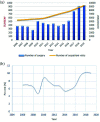Trends in benign prostatic hyperplasia surgery over the years: A multicenter 14-year retrospective study
- PMID: 35118969
- PMCID: PMC9612752
- DOI: 10.5152/tud.2021.21262
Trends in benign prostatic hyperplasia surgery over the years: A multicenter 14-year retrospective study
Abstract
Objective: The aim of this study is to show the surgical trend over the past 14 years using the data from five major centers in Turkey with accumulated experience in benign prostatic hyperplasia (BPH) surgery.
Material and methods: This study included 94,954 patients with low urinary tract symptoms (LUTSs) secondary to BPH. By using electronic databases, we identified 7,163 patients who underwent BPH surgery, including monopolar transurethral prostate resection (M-TURP), bipolar transurethral prostate resection (BTURP), transurethral incision of the prostate (TUIP), open prostatectomy (OP), and holmium laser enucleation of the prostate (HoLEP) from 2006 to 2019. The years were grouped as 2006-2010, 2011-2015, and 2016-2019.
Results: The total number of outpatient treatments for BPH increased by 72.9% from 5,379 in 2006 to 9,302 in 2019. Until 2019, the annual number of surgeries increased from 375 to 937 (increasing 150%). All surgical approaches for BPH, except TUIP, were most frequently performed between the ages of 60 and 69. The rate of surgery including M-TURP, B-TURP, and TUIP was statistically different between 2006 and 2010, 2011 and 2015, and 2016 and 2019 (P < .001), except OP (P ¼ .071). The highest increase was observed in HoLEP in the first half of the 2010s compared to the second half of the 2010s. The rate of M-TURP decreased from 77.9% to 17.9% from 2016 to 2019.
Conclusion: With the aging population, the number of patients diagnosed and treated with BPH is increasing. B-TURP as a resection technique and HoLEP as an enucleation technique replace M-TURP. Healthcare services and government spending should be organized according to these data.
Conflict of interest statement
Figures





References
-
- Gravas S, Cornu J, Drake M.et al. EAU Guidelines on Non-Neurogenic Male LUTS Including Benign Prostatic Obstruction . Arnhem: European Association of Urology, 2019.
-
- Naspro R, Manica M, Meneghini A.et al. From. “gold standard” resection to reproducible. “future standard” endoscopic enucleation of the prostate: What we know about anatomical enucleation. Minerva Urol Nefrol . 2017;69:(5):446–458..
LinkOut - more resources
Full Text Sources
Miscellaneous
